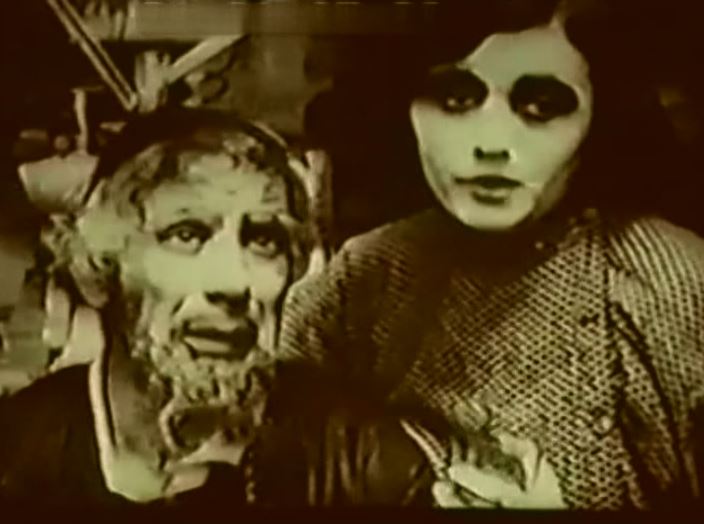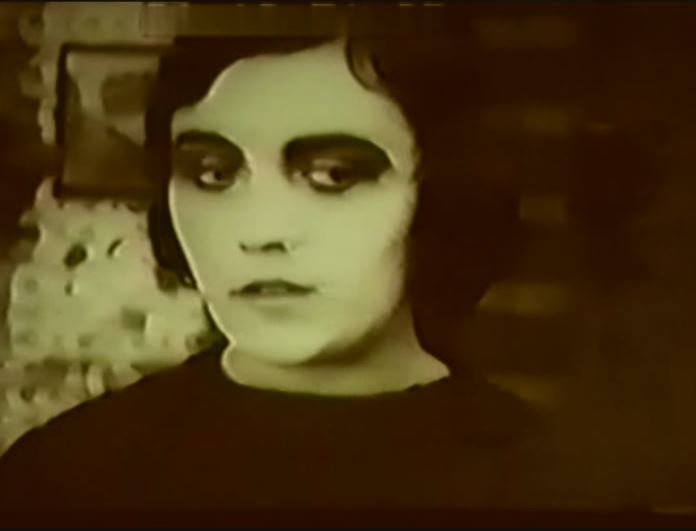

Der gelbe Schein ist ein deutsches Stummfilmmelodram von Victor Janson und Eugen Illés aus dem Jahr 1918. Die historische Grundlage des Film war die Regelung im zaristischen Russland, dass die einzigen jüdischen Frauen, die sich in St. Petersburg permanent niederlassen durften, gelbe Identifikationsscheine besitzen mussten. Diese jedoch wurden nur an Prostituierte ausgegeben. Die Regelung wurde erst nach der Oktoberrevolution abgeschafft.
Ein Dorf, irgendwo in Polen: Der verwitwete jüdische Pfandleiher Scholem Raab wird von seiner Tochter Lea aufopferungsvoll gepflegt. Ihr Lehrer Ossip Storki, der die Stadt verlässt, um als Erzieher in der Fremde tätig zu werden, besucht noch einmal den todkranken Scholem, der ihm ein geheimes Dokument überreicht: Lea ist in Wirklichkeit nicht seine Tochter. Vor Jahren brach eine russische Frau vor Scholems Haus mit einem Baby zusammen und Scholem und seine Frau nahmen beide bei sich auf. Am nächsten Tag war die Frau verschwunden und Scholem zog das Kind auf. Nach dem Tod Scholems geht Lea für ein Medizinstudium nach St. Petersburg. Da sie keine Aufenthaltsgenehmigung besitzt, erhält sie keine Wohnung in der Stadt. Auf der örtlichen Polizeistation meldet sie sich für einen „gelben Schein“ an und wartet mit einer Gruppe von Prostituierten auf ihre Papiere, die ihr nach langer Wartezeit ausgehändigt werden. Als sie auf der Straße erschöpft zusammensinkt, hilft ihr die junge Vera, die sie bereits auf der Wache gesehen hat. Sie besorgt ihr ein Zimmer bei einer Frau, die auch ein „Ballhaus“ führt, das in Wirklichkeit eher einem Freudenhaus gleicht. Die Frau schlägt vor, dass Lea hin und wieder einige von ihr organisierte Feiern besucht. Als Lea ihre Sachen auspackt, findet sie auch ein Buch wieder, das Ossip Storki ihr vor seiner Abreise geschenkt hatte. Es gehörte einst seiner nichtjüdischen Schwester Sofia – im Buch findet Lea zwischen den Seiten deren Ausweispapiere. Lea schreibt sich als Sofia Storki an der Universität ein, wo sie Medizinvorlesungen bei Professor Schukowski hört und schon bald zu den besten Studenten zählt. Sie beginnt als Sofia Storki, als die sie sogar einen Preis aus den Händen Professor Schukowskis erhält, eine Beziehung mit dem Studenten Dimitri, während sie als Jüdin Lea für ihre Vermieterin als Amüsierdame arbeiten muss.
Der gelbe Schein wurde zum Ende des Ersten Weltkriegs teilweise im jüdischen Nalewski-Vierten in Warschau gedreht. Polen war zu dem Zeitpunkt noch von deutschen Truppen besetzt. Andere Teile entstanden in den Ufa-Union-Ateliers Berlin-Tempelhof. Der gelbe Schein war ursprünglich als Propagandafilm gegen das Russische Kaiserreich konzipiert worden. Der Film wurde jedoch erst am 22. November 1918 uraufgeführt, als das Zarenreich bereits untergegangen war. Die aktuellere Kritik sieht in Der gelbe Schein zwar einerseits das propagandistische Element – „während Russland als Hort der Rückständigkeit und des staatlich verordneten Antisemitismus erscheint, soll Deutschland im Umkehrschluss für religiöse Toleranz, Kultur und Fortschritt stehen“
The Yellow Certificate (the other name for this film, also titled, The Yellow Ticket) is a German silent film melodrama by Victor Janson and Eugen Illes from the year 1918. The historic basis for the film was the regulation in Czarist Russia, that the only Jewish women who were permitted to reside in St. Petersburg were those who possessed a yellow identification certificate. This, however, was only given to prostitutes. It wasn’t until the October Revolution that this restriction was lifted.
In a village, somewhere in Russian Poland: The widowed Jewish pawnbroker Sholem Raab is sacrificially cared for by his daughter Lea. Her teacher, Ossip Storki, who is leaving the city to become a teacher abroad, pays a final visit to the dying Sholem, who gives him a secret document: In reality, Lea is not his daughter. Years before, a Russian woman appeared at Sholem’s house with a baby and Sholem and his wife took both of them in. The next day, the woman disappeared and left behind the child for Sholem to raise. After Sholem’s death, Lea leaves for St. Petersburg to study medicine. Since she has no residency permit, she can’t get an apartment in the city. At the local police station, she applies for a “yellow certificate” and waits with a group of prostitutes for her papers, which are handed back to her after a long wait. When she sinks to the ground exhausted in front of the police station, the young Vera comes to her aid and finds a room for Lea in a “dancing hall”, which, of course, is actually a brothel. The madame of the “dancing hall” suggests, that Lea might want to entertain some guests now and again. When Lea unpacks her bags, she finds a book, which Ossip Storki gave to her before his departure. It once belonged to his gentile sister Sofia. In the book, Lea finds identification papers between the pages and thus decides to enroll at the university as a gentile. As Chrisitan Sofia Storki, she soon becomes one of the most gifted students in the medical faculty, even receiving a prize from Professor Schulkowski for her work. But back home in the brothel, she’s once again Jewish Lea, who has to work off her rent as a lady of the evening.
The Devil’s Pawn was made at the very end of the First World War while hostilities were still in effect. It was partly filmed in the Nalewski quarter of Warsaw, the former Jewish ghetto, and for that reason alone, the film gives a rare look at a district in Warsaw subsequently razed by the Germans during the Warsaw Ghetto revolt, never to be rebuilt. At the time of this filming, Poland was still occupied by German troops and other parts of Warsaw, shown in the film, are meant to stand in for St. Petersburg. In a rather ironic twist – taken from hindsight – the film was meant to criticize the Russian Empire as the preserver of backwardness and anti-Semitism, while portraying Germany as a bastion of tolerance, culture and progressiveness. While no doubt meant to serve as an anti-Russian propaganda film, by the time it made its debut, the Czarist empire had ceased to exist. Considered “remarkably progressive for its time”, the majority of the film’s prints were destroyed by the Nazis.
DVD-R HAS ENGLISH INTERTITLES
See film sample for audio and video quality.
LENGTH OF FEATURE FILM: 47 mins.




